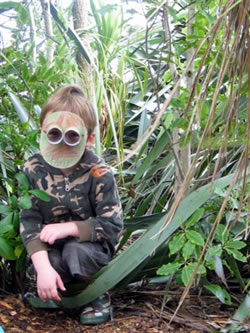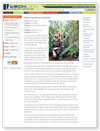Watching without being seen
 Class: New Entrant
Class: New Entrant
Teacher: Kim Death
School: Horsham Downs Primary School
Category: Classroom unit
Duration: Six hours
Kim Death's New Entrant class had been studying dinosaurs as part of a Science unit and she had the task of planning the Technology aspect of this thematic unit.
"The children loved imagining what it would be like if dinosaurs were still around today, and this led to a discussion on how people could observe dangerous animals safely without being seen," said Kim.
She decided to follow up this interest with a Technology unit on 'Camouflage'.
The children were asked to do an initial plan of how they could watch wild animals in the school's bush area without being seen. "These were very 'blue sky' ideas", said Kim, "and ranged from tree huts, trucks and cages to hiding behind a tree."
Next the children researched how animals use camouflage in the wild, by examining pictures from books and the internet. From this they developed ideas such as: that animals survive by matching their background environment; the camouflaging effect of patterning, such as stripes and mottled colours; the importance of staying still; and borrowing items from the environment (as hermit crabs do).
An enjoyable time playing hide-and-seek in the bush area helped reinforce these ideas as the children identified who was easy and who was hard to find, and worked out why.
Back in the classroom, Kim had downloaded some images showing how humans already use camouflage. These included masks, Mai Mai huts, face paint, ghillie suits, animal hides, foliage, camouflage clothing – and the pros and cons of using each were discussed.
A second plan was formulated with a focus on developing outcomes relating to the conceptual statement: 'Design a way to watch without being seen'. Kim emphasised that these had to be possible to make using resources the children could obtain for themselves.
The children then had a quick go at implementing their plans and tested their outcomes for different purposes in the bush area. Criteria for judging included 'the best looking', 'the best camouflaged', 'the strongest', 'the best to move around with'. 'the least expensive', the least harmful to the bush area', and 'the most comfortable'.
"The children contributed lots of good ideas about fitness for purpose," said Kim. "Mobility, durability, sustainability, cost effectiveness, user friendliness and aesthetics were all issues which came up in the discussion."
The unit finished with an assessment task focussing on Brief Development, which Kim carried out through a quick interview with each child.Kim is confident that it is a unit which can be successfully repeated, but in retrospect feels that she could have taken more time to provide resources to support those children who didn't bring any materials to make their camouflage "Each child wrote a list of things they needed and most did bring stuff but a few didn't and I didn't have enough spare things to fill the gap."
Working alongside Kim was Technology Adviser Mike Rogers. Mike puts a large part of the success of the unit down to teacher understanding of the components of Technological Practice. "Kim was very flexible and able to work within the context that was suggested," he says. "And what was perceived initially as a difficult topic for teaching Technology evolved into a hands-on, exciting unit. This was a successful way to introduce an element of authenticity."
Kim feels that "the whole hiding from a scary dinosaur idea" captured the students' imaginations and made it exciting. " The practical aspect of testing out their ideas by playing hide-and-seek and studying their own camouflage photos and discussing them gave instant feedback."


